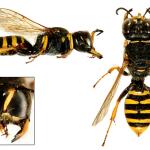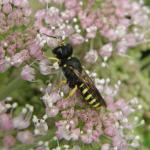Crabro cinctus (SPINOLA,1806); Crabro flavipes (BLANCHARD,1940); S[hex interruptefasciatus (RETZIUS,1783); Crabro maculate (PREYSSLER,1793); Crabro octomaculatus (SCHRANK,1802); Crabro planifrons misident.; Crabro quadricinctus (FABRICIUS,1787); Crabro saundersi (PERKINS,1899); Crabro tetraedrus (BLANCHARD,1940); Crabro tibialis (OLIVIER,1792); Crabro vespiformis (PANZER,1798); Crabro yosemite PATE,1946; Crabro zonatus (PANZER,1798,CRABRO)
A large Ectemnius closely resembling the common E. continuus, but considerably scarcer. Formerly known under the names zonatus (Panzer, 1797), saundersi (Perkins, R.C.L., 1899) and quadricinctus (misidentification). The last name was also shared with E. cephalotes, making some old records impossible to assign.
Sparsely recorded throughout England an d Wales, extending as far north as the Whitby area of North-east Yorkshire. No clear northern or southern bias is apparent, though it appears to have increased its presence in northern England over recent decades, whilst declining in counties such as Dorset. Unrecorded in Ireland, and no records for the Channel Islands since 1958. Found in central and southern Europe, and through Siberia to China.
A Nationally Notable (Nb) species (Falk, 1991).
Recorded from a similar variety of habitats to E. cavifrons, utilising coastal, rural and urban locations. Usually most evident around large pieces of dead wood or on umbellifer flowers.
Univoltine; May to September.
Nesting typically occurs in burrows in dead wood such as tree stumps, fence posts, building timbers, the dead parts of living trees and the dead woo d associated with scrub (Lomholdt, 1975-76; Hamm & Richards, 1926). R C L Perkins (1899) additionally cites a huge colony found in a cliff face at Sidmouth, though ground-nesting is not typical of any British Ectemnius species. The author is unaware of any other similar claim for this species, although the habit has been noted in the non-British E. fossorius (Linnaeus). Nests are stocked with a variety of medium-sized flies such as calypterates and syrphids. The larva has been described by Maneval (1937).
Umbellifers such as hogweed, wild angelica, carrots, wild parsnip, fennel and hemlock.
None known, but parasitoids are likely to include anthomyiid and sarcophagid flies.
1998



